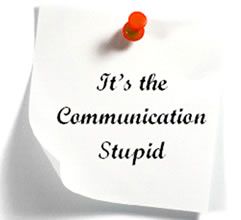Champion of Change – The Business Analyst
 Six months after implementation of a new software application, complaints were heard, such as “The software doesn’t work” or “It’s too cumbersome.” After several weeks of post-implementation analysis I determined that the problem was not with the system but rather the resistance by the users to the changes required by the new system. This resistance had become so strong that a replacement of the new application was already being considered.
Six months after implementation of a new software application, complaints were heard, such as “The software doesn’t work” or “It’s too cumbersome.” After several weeks of post-implementation analysis I determined that the problem was not with the system but rather the resistance by the users to the changes required by the new system. This resistance had become so strong that a replacement of the new application was already being considered.
Upon completion of a project, the organization will have to cope with the inevitable changes that will affect the business. This is a classic example of where the business analyst has to be a “Champion of Change” and mitigate the impact of new systems on workers at all levels in the organization. Project success doesn’t just mean delivering on time and on budget — but includes genuine acceptance by the people in the organization who will benefit or, in some cases, be impacted negatively by the new implementation. This aspect of the project is often lightly touched upon or brushed aside as the BA views these changes as merely part of project communications (“Just tell the employees what needs to be done in the future”), or training (“Just send them to a training session”). In reality, acceptance of change can either make or break a project effort and needs to be addressed throughout the project.
The implementation of the application will always result in some change to the organization’s structure, processes, systems and/or jobs. Whenever change of any type happens within the organization it requires extensive planning and hard work to ensure the change is implemented in a manner that will be embraced by all. This change applies to all individuals, or stakeholders, who will be impacted by the results of the project. They are the ones that Mark Twain’s quote would apply to best, “I’m all for progress. It is change I don’t like.”
The business analyst utilizes a set of tools and techniques to elicit and manage the business requirements. These are usually focused on understanding the requirements necessary for the software and technical aspects of the application and can challenge a business analyst’s “hard skills.” On the other hand, the “soft skills” of a business analyst need to stay focused on the stakeholders and workers impacted by the change that is inevitable. This includes providing support and empathy in addressing resistance while helping mitigate the eventual impact of the final solution to the organization.
Stages of Change
When business change is inevitable, the business analyst needs to be aware of and identify:
- Specific organizations and jobs that will be impacted
- Individual business persons from those organizations who will most likely accept the changes as well as those who will resist the changes
- Potential discussions that can be facilitated to address the changes that will occur, giving individuals the opportunity to share their concerns, provide feedback and ask questions
- Concerns that need to be addressed in order to potentially move stakeholders from a non-supportive to a supportive position
Understanding the various stages that a person goes through when presented with change will also help determine the appropriate way to proceed.
- Denial of change
- Response of anger and resistance
- Acceptance and adaption to the change
- Commitment to the new way
During this time it is critical to continually monitor the resistance, as well as the acceptance to the new environment, as various stakeholders progress through these stages at different rates.
Communication
A communication plan will need to be targeted for each of the different audiences impacted by the change to ensure that the most effective communications methods are being utilized. The BA needs to identify the right message, at the right time, the right format and the right “authorized” sender to carry the message to the organization.
These types of communications are often best conveyed by someone in the organization, other than the BA. By working with management and project sponsors, a strong and active coalition of senior “leaders” can be gathered to craft the key messages, or “sound bites” that must be communicated. Just as in political debates, often impressions are made based on a few words, and therefore these words need to be very carefully chosen.
The initial emphasis should focus to making the case of “why” the change is needed, even before the specific details of the solution are complete. This is very similar to the development of a marketing plan for a “product”, without which no new product would be expected to be successful when “rolled out”.
These messages need to be incorporated into the development of a training plan that will include not only the normal operational training aspects but also the “selling” of the benefits or reason behind the change. This may require not only formal training, but also potential mentoring and coaching to effectively enable the change throughout the organization.
Final Thoughts
To truly become a champion of change, the business analyst should consider the following suggestions:
- Seek support from management and then support them.
- Choose your battles wisely with the people, management or supervisors.
- Be patient with the rate of acceptance; some take longer to see the light.
- Be tolerant of mistakes; they happen.
- Practice good stress management; you’ll need it
- Have a sense of humor; you have to laugh sometimes.
- Embrace the future and don’t get “bogged down” by the past.
- Recognize and reward the accomplishments of those who were instrumental in enabling the change – Yes, it’s time to party
Most of all, remember the purpose of a project is to provide a benefit or improvement for the organization, and with that, something must change. If there was no need for change, there would be no need for business analysts!!!
Steve Blash is an experienced IT professional consultant providing business and technology leadership, mentoring and vision. His areas of experience include business process improvement, business analysis, business intelligence, data analytics, project and IT management.


 I was reading a book that talked about how the phrase “It’s the economy stupid” was born. This phrase was created and used by the 1992 Bill Clinton presidential campaign when he was running for U.S. President. According to the story, James Carville wrote three things on a white board to help the campaign get focus. One of the items on this internal list was “The economy, stupid”. He wanted the campaign to stress how Bill Clinton’s opponent, George H. W. Bush, did a poor job with the economy during his first term in office. This is a very simple and clear direction for the campaign. It helped them make decisions on how to answer questions from reporters and when creating and delivering campaign speeches. This phrase was a big reason Bill Clinton went on to win the election.
I was reading a book that talked about how the phrase “It’s the economy stupid” was born. This phrase was created and used by the 1992 Bill Clinton presidential campaign when he was running for U.S. President. According to the story, James Carville wrote three things on a white board to help the campaign get focus. One of the items on this internal list was “The economy, stupid”. He wanted the campaign to stress how Bill Clinton’s opponent, George H. W. Bush, did a poor job with the economy during his first term in office. This is a very simple and clear direction for the campaign. It helped them make decisions on how to answer questions from reporters and when creating and delivering campaign speeches. This phrase was a big reason Bill Clinton went on to win the election.
 One of the ways we can unknowingly hold our careers back is failing to understand and communicate our value effectively. Many of the business analysts I work with in their job search and career development initially lack an appreciation for how they contribute to the organization’s bottom line.
One of the ways we can unknowingly hold our careers back is failing to understand and communicate our value effectively. Many of the business analysts I work with in their job search and career development initially lack an appreciation for how they contribute to the organization’s bottom line.